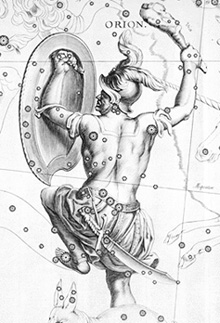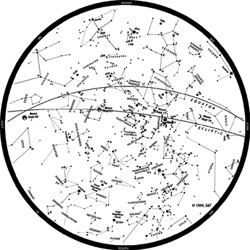"Constellation" is the name we give to seeming patterns of stars in the night sky. "Stella" is the Latin word for star and a constellation is a grouping of stars. In general, the stars in these groups are not actually close to each other in space, they just appear to be close when viewed from Earth.
If we could travel by spaceship to another part of the galaxy, we would imagine an entirely different set of constellations. In the meantime, for us on Earth, the constellations are a handy way to locate a star in the sky.
On Earth, we see different constellations as we travel to different parts of the globe. The fact that some constellations were visible in the northern hemisphere and not the southern hemisphere, and vice-versa, was used more than 2000 years ago by Greek astronomers to argue that the Earth is round.
Johannes Hevelius' Orion from
URANOGRAPHIA (1690)
Long before the invention of the telescope, early civilizations invented star patterns and named them after animals, objects, heroes, gods, and beasts from stories and myths. Many of these myths were probably created to explain changes in the sky due to seasons, etc. The ancient Greeks named many constellations. For example, they told the story of Orion, the hunter, who leaped into the sea to escape a scorpion’s bite, which explained why the constellation Orion disappears from the sky when the constellation Scorpius rises. Different civilizations imagined different patterns, and some stars were included in more than one pattern. Over time, the situation became confusing.
In 1929 the International Astronomical Union defined 88 constellations that are today recognized as the "official" constellations. Many of these constellations are derived from the complex creations of Greek mythology, like Andromeda, Perseus, and Orion. Others came from ancient cultures such as the Egyptians and Chaldeans and still others were not defined until the 17th and 18th century.
In the past, people used the constellations as markers. Some used the constellations to navigate their boats across the sea, to mark seasons of the year, or to locate special stars. Today, astronomers still use constellations as a handy marker to indicate a general area of the sky where far away celestial objects appear. Many of these extremely distant objects can be seen only with powerful telescopes.
In the next sections you will find short descriptions of some of the constellations in which Chandra images are located. But remember that "in" doesn't really mean "in." It means “in the same direction.” The stars that make up the constellations and many of the sources that Chandra observes are at very different distances from Earth.
Please Note:As mentioned above, the stories associated with the constellations come from many cultures and most exist in several variations. The purpose of this section is to give an overview of the main legends behind the constellations that mark those parts of the sky in which the Chandra images on this web site are located. While we give more details from the story associated with the official name of the constellation (as adopted by the International Astronomical Union), we also mention other legends and stories connected with a particular pattern. However, there are so many stories, from so many cultures, and so many variations on even well known stories, that we can only present here a summary. To help you find out more about the many legends associated with constellations, we include a reference list of the sources that we consulted in compiling this overview, both printed and on-line. We encourage you to continue your own reading about the constellations. The sources we cite are a good start, but by no means a complete list of the resources that exist.
Introduction to Constellations | Constellation Sources | Constellations Index



